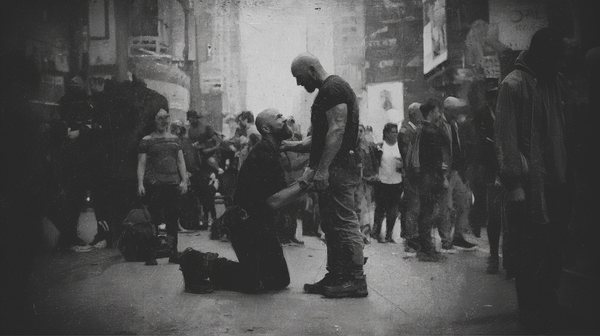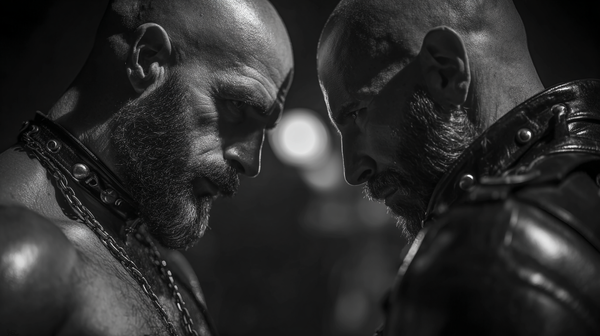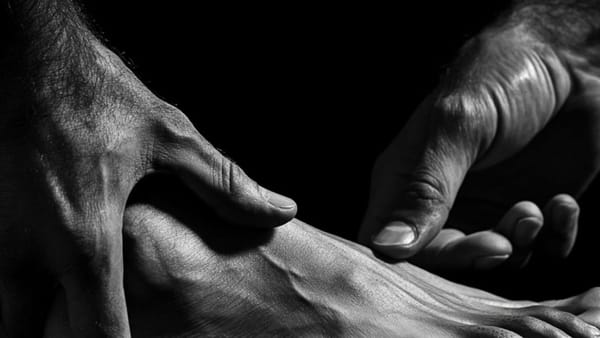The Difference Between Submissive and Slave
The difference between a submissive and a slave isn’t about value—it’s about nature. One obeys. The other belongs. In this post, I break down what truly separates them—and why, as a Master, I seek not obedience, but surrender.

In the world of BDSM, words matter. They shape dynamics, define expectations, and carry the weight of identity. And yet, submissive and slave are terms that often get thrown around as if they mean the same thing. I’ve even caught myself using them interchangeably on occasion. But the truth is—they don’t mean the same thing at all.
This post is not meant to draw a line in stone, but to share how I see the distinction, based on my own journey, my experience as a Master, and the dynamics I’ve lived and shaped over time.
No One Is Better—Just Different
Let’s get this out of the way: one is not better than the other. A slave is not just a submissive who “leveled up”. The two roles represent entirely different needs, desires, and ways of existing within power exchange.
Some Masters—myself included—are instinctively drawn to those we recognize as slaves. There’s something unmistakable in them: a quiet hunger to surrender more completely, to hand over not just their body or obedience, but the very structure of their life. It’s not about passivity—it’s about purpose. A submissive, on the other hand, may serve with dedication and even devotion, but will eventually need to draw a line, to retain a space that is still theirs. And that line, however natural it may be for them, is precisely where a Master will find the limit of what that dynamic can become.
The same is true on the other side of the leash. A slave may feel frustrated with a Dominant who doesn’t offer the kind of structure, presence, or ownership he craves. A submissive might find himself overwhelmed under the intensity of a Master who expects absolute control. When there’s a mismatch, no amount of desire will fix it. The dynamic breaks.
Some Dominants love to say that a slave is more evolved than a submissive. I don’t buy that. That’s an excess of ego talking—projecting preference as hierarchy. The truth is simpler: different wiring, different needs, different roles.
As for me—I identify not just as a Dominant, but as a Master. That’s not a title I picked up for aesthetics. It reflects who I am at my core. I don’t just want obedience—I want ownership. I don’t just want service—I want surrender. I don’t seek to play a role. I seek a lifestyle.
The Mindset Behind Submission and Slavery
As I mentioned earlier, being a slave isn’t about being “better” than a submissive. But it is about being different. The nature of the relationship changes. The depth of devotion changes. And yes—the courage it requires changes too.
A slave doesn’t just submit. He surrenders. He doesn’t simply obey commands—he gives up the right to choose. Not for a scene, or a weekend, but as a lifestyle. As his identity. A slave lives in function of his Master’s will, and that kind of surrender requires a very specific mindset—one that not everyone is born with.
A submissive may enjoy kneeling, serving, even being used. He may offer himself wholeheartedly, until the scene ends, the weekend is over, or the context shifts. At some point, he will return to his life. He may still crave the dynamic, still identify as a submissive—but he retains the option to leave, to draw a line, to reassert his independence. A slave does not.
A Slave Hands Over His Life
Some people draw the line between a submissive and a slave at sex. They’ll say a submissive offers service primarily in a sexual or fetish context, while a slave goes further. That’s partially true—but it misses the core of what defines a slave.
I’ve known submissives who have gone well beyond the bedroom—used as human furniture, ashtrays, public urinals, humiliated, dehumanized, put to domestic use. But even then, there’s a point where they step out of the scene and back into their lives. That exit still exists for them.
A slave doesn’t want the exit. He doesn’t just enjoy being controlled—he needs it. He finds peace in it. He functions through it. He craves the structure, the presence, the ownership. And above all, he needs to serve. Not for an hour, not for a night. Always.
That’s the core difference.
A slave is not looking for kinky escapism. He is seeking to be shaped. Reforged. To be stripped of the burden of choice, and guided by the will of the one who owns him.
He wants the Master to decide what he wears, how he looks, what time he wakes up, what he eats, how he trains, how he lives. Not out of weakness—but because in that surrender, he becomes what he was meant to be: a tool for service, devotion, and worship. And through that, he finds purpose.
A Slave Does Not Have a Safeword
Submission is primal. It is the recognition of a hierarchy that already exists. The Alpha commands. The submissive kneels. The order of things falls into place—not by force, but by nature.
But here’s something that’s often misunderstood: a submissive doesn’t kneel for just anyone. He doesn’t consider himself inferior to the world. He recognizes power when he sees it—and submits to it when it resonates with his instincts. A Dominant doesn’t receive obedience. He earns it.
A submissive will learn how to serve. He’ll discover what pleases his Dominant. He’ll be trained in rituals of obedience—bootlicking, bondage, punishment, piss play, pain. He’ll grow under the Dominant’s hand. But through it all, he retains one thing: control.
The submissive has a safeword. He can say “enough.” He can draw the line. The dynamic may be deep, intense, intimate—but it remains a negotiation. The submissive can walk away if the terms no longer serve him.
A slave, however, does not negotiate—at least not once the contract is sealed.
He doesn’t submit. He surrenders. Fully. And that kind of surrender can’t happen in a scene. It’s not a roleplay. It’s not a kink checklist. It is a transformation that unfolds over time—rooted in trust, forged through presence, and shaped by the hands of his Master.
The slave gives up more than control of his body. He gives up the burden of choice. He surrenders his voice, his doubts, his decisions. His thoughts stop being his own. The Master becomes the center of gravity—the axis around which the slave’s existence revolves.
And no, the slave does not have a safeword. He doesn’t need one. Not because he’s reckless, but because his surrender is total. His Master knows him—his limits, his weaknesses, his strength—and owns the responsibility to protect, guide, and use him.
That’s not abuse. That’s ownership. And a true slave needs to be owned.
Being a Slave Is a Lifestyle—and a Perpetual Mindset
For the submissive, BDSM is one part of a larger identity. He may serve with intensity, crave Dominance deeply, even see submission as part of who he is—but it exists alongside his job, his relationships, his hobbies, his everyday life. Submission fits into the space he creates for it.
For the slave, that space does not exist. He doesn’t make room for slavery in his life. His life is built around it. Being a slave is not what he does—it’s who he is.
And that identity doesn’t emerge overnight. It develops through time, through service, through deep, deliberate exposure to his Master’s control. It is shaped by a relationship where power is not negotiated—it is given, and it is claimed.
That doesn’t mean a slave has to give up his job, his friendships, or disconnect from the outside world. But it does mean he allows his Master access to every corner of his life. The Master’s presence—His control, His will—extends far beyond the bedroom. It reaches into everything.
A good Master doesn’t abuse that access. He uses it. Thoughtfully. Purposefully. He weaves His control into the everyday reality of His slave in ways no one else can see—but the slave always feels.
Chastity is one of my favorite tools. Silent, constant, powerful. But there are countless others. A plug. A rope harness beneath the clothes. An instruction whispered in the morning that echoes all day. These are not just fetishes. They are reminders. Symbols of ownership. Anchors for the mind.
A slave walks through the world with that constant awareness: I am His. Every interaction, every decision, every moment is filtered through that truth.
A submissive will draw a line long before that. He may serve, but he keeps certain things off-limits. His body. His image. His routines. His appearance. He would recoil at the idea of shaving his head on command—or being branded with his Dominant’s mark, permanently inked into his skin. But a slave sees those things for what they are: acts of devotion. Proof of surrender.
That is the difference. The submissive explores control. The slave lives in it.
A Slave Is Not an Equal
When a scene ends, the submissive may rise from his knees, wipe the sweat from his brow, and return to casual conversation. The Dominant becomes his friend again. Maybe they grab a drink. Maybe they laugh. Maybe the sub slaps him on the back and calls him “dude.”
There’s no shame in that—it’s part of the dynamic they’ve agreed to. A temporary power exchange. A game, even if it’s intense. A dance between equals.
But a slave doesn’t return to equality. Because he never left the hierarchy to begin with.
He does not call his Master “dude.” He walks one step behind. He lowers his gaze unless permitted to lift it. The structure is not a scene—it’s a reality.
He does not sit at the same table unless allowed to. And even then, he knows that he sits there because the Master allows it—not because he’s entitled to it. His rightful place is lower. Beneath. At the feet of the one who owns him.
A slave doesn’t live in the illusion of parity. He is not a partner. He is not a friend. He is not an equal.
He may be a beast—trained, shaped, refined to the Master’s taste. He may be a tool—sharpened to serve. He may be a body—muscled, sculpted, on display for the Master’s pride and pleasure. But whatever form he takes, he is not his own.
He belongs.
Born or Made?
I plan to dedicate an entire post to the question of whether Dominants and Masters—or submissives and slaves—are born or made. It’s a question that’s followed me since the moment I awoke to the world of BDSM, and one that still lingers in the back of my mind every time I look into the eyes of a new submissive.
For now, I’ll say this: I believe hierarchy isn’t merely something we choose. It’s something we are. Our place within it is often written before we know how to read it. Some are born to kneel. Others are born to command. And some—rare ones—are born to surrender completely.
Not every submissive is a slave. And not every man who serves has the wiring required to give up his will entirely. But when you encounter someone who was born a slave, something shifts. It may have been buried beneath layers of shame, confusion, or conditioning—but once uncovered, the truth is undeniable.
Expose him to control. Show him structure. Make him feel what it’s like to belong. And soon, you’ll see it in his eyes: the hunger, the ache, the quiet desperation to be shaped, used, owned. It’s a transformation that never gets old. It’s a privilege to witness. And it’s one of the greatest rewards of being a Master.
Let me be clear again: none of this is to say that a slave is better than a submissive. Not at all. They are different—wired for different dynamics, drawn to different depths. Both deserve respect, care, and the right Dominant to guide them. But as a Master—not just a Dominant—I know what I crave.




